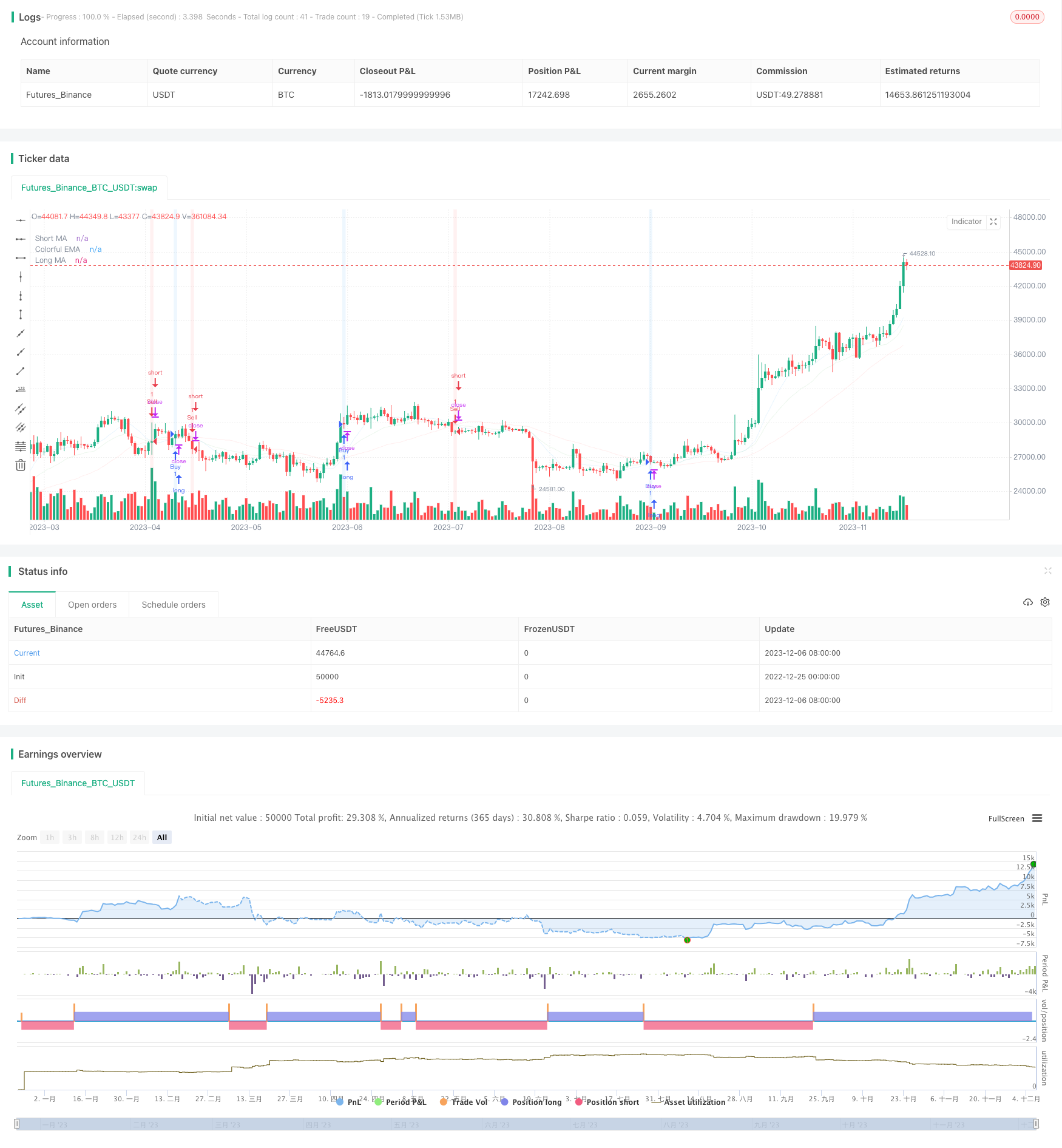Moving Average Crossover Strategy
Author: ChaoZhang, Date: 2023-12-26 12:04:34Tags:

Overview
The moving average crossover strategy is a timing strategy based on moving averages. It generates buy and sell signals by calculating different period moving averages and judging their crossover. This strategy also combines the exponential moving average as an auxiliary indicator to further improve the accuracy of signals.
Principles
The core logic of this strategy is based on the crossover between two moving averages. Specifically, it calculates the n-day simple moving average (short MA) and the m-day simple moving average (long MA). When the short MA breaks through the long MA from bottom to top, a buy signal is generated. When the short MA breaks through the long MA from top to bottom, a sell signal is generated. This reflects the wash and correction of short-term trends on long-term trends.
In addition, this strategy also introduces the x-day exponential moving average (EMA) as an auxiliary indicator. Compared with SMA, EMA is smoother and can reflect price changes faster. Its auxiliary effect is that only when the short-term EMA also confirms the moving average crossover signal, the actual trading signal will be triggered. This avoids some interference from false signals and improves the stability of trading strategies.
Advantages
The moving average crossover strategy has the following advantages:
-
Simple and easy to use. This strategy relies solely on the crossover between two moving averages, which is very simple, easy to understand and implement.
-
Intuitive and vivid. Moving averages can clearly reflect market trends, and their crossover is also very intuitive without complex calculations.
-
Long history. Moving average strategies can be traced back to the early 20th century and have undergone 100 years of market test to become one of the classic technical analysis tools.
-
Controllable risks. By adjusting the moving average parameters, you can control the frequency of trading signals and thus control risks.
-
Universal and flexible. The moving average crossover strategy is suitable for various products and time cycles, making it a very versatile and flexible trading strategy.
Risks
This strategy also has some risks:
-
Frequent position switching. When the market fluctuates sharply, the moving averages may frequently crossover, resulting in over-frequent position switching.
-
Lagging effects. The moving average itself carries a certain lag, especially long-cycle moving averages, which may miss short-term trading opportunities.
-
Parameter optimization needed. For different products and time cycles, the parameters of the moving averages need to be independently tested and optimized, otherwise the results may be poor.
-
Can be combined with other indicators. A single moving average strategy is not the best performing. It often requires other technical indicators to filter out signals.
Optimization Directions
This strategy can be optimized in the following aspects:
-
Adjust moving average parameters to adapt to different cycles. Different combinations of short-term and long-term moving averages can be tested to find the optimal parameters.
-
Add auxiliary judgment of trading volume. For example, set up indicators for breaking through trading volume to avoid invalid signals.
-
Add volatility indicators for judgment. For example, KDJ and MACD can judge the actual market trend and filter uncertain signals.
-
Combine fundamentals. Adjust parameters based on earnings expectations to make strategies more forward-looking.
-
Portfolio application of strategies. Use with other strategies or models to achieve synergistic effects.
Conclusion
The moving average crossover strategy generates trading signals through the simple principle of moving average crossover. It is intuitive, easy to understand, flexible in parameter adjustment and risk controllable. But it also has inherent lagging properties and risks of over-frequent position switching. Therefore, this strategy can be optimized and combined in various ways to maximize its utility. It has become a simple and effective basic strategy in quantitative trading.
/*backtest
start: 2022-12-25 00:00:00
end: 2023-12-07 05:20:00
period: 1d
basePeriod: 1h
exchanges: [{"eid":"Futures_Binance","currency":"BTC_USDT"}]
*/
//@version=5
strategy("MA Crossover Strategy", overlay=true)
// Define input parameters
shortLength = input(10, title="Short MA Length")
longLength = input(40, title="Long MA Length")
emaLength = input(20, title="EMA Length")
// Calculate moving averages
shortMA = ta.sma(close, shortLength)
longMA = ta.sma(close, longLength)
colorfulEMA = ta.ema(close, emaLength)
// Create buy and sell conditions
buyCondition = ta.crossover(shortMA, longMA)
sellCondition = ta.crossunder(shortMA, longMA)
// Execute buy and sell orders
if (buyCondition)
strategy.entry("Buy", strategy.long)
strategy.close("Sell")
if (sellCondition)
strategy.entry("Sell", strategy.short)
strategy.close("Buy")
// Color the background based on buy and sell conditions
bgcolor(buyCondition ? color.new(color.blue, 90) : na)
bgcolor(sellCondition ? color.new(color.red, 90) : na)
// Plot moving averages
plot(shortMA, color=color.new(color.blue, 90), title="Short MA")
plot(longMA, color=color.new(color.red, 90), title="Long MA")
// Plot colorful EMA with transparency
plot(colorfulEMA, color=color.new(color.green, 90), title="Colorful EMA")
- Bollinger Band RSI Dual Line Strategy
- Dynamic Support Resistance Breakout Trend Strategy
- Rainbow Oscillator Backtesting Strategy
- Larry Williams' Moving Average Crossover Strategy
- Oscillator Differential Moving Average Timing Strategy
- A DMI & Stochastic Trading Strategy with Dynamic Stop-loss
- Dual-Factor Combo Reversal and Mass Index Strategy
- Quantitative Trading Strategy Based on Double Trend Filter
- Stochastic RSI Momentum Oscillation Trading Strategy
- Trading Strategy of Short Selling When Bollinger Band Crosses Below Price with RSI Callback
- Trend Tracking Strategy Based on Dynamic Pivot Bands
- Bollinger Bands Momentum Trend Following Strategy
- Dynamic Buying Selling Volume Breakout Strategy
- Supertrend MACD Quantitative Strategy
- 4 EMA Trend Strategy
- Bitcoin Trading Strategy Based on Quantitative Indicators
- Last N Candle Reverse Logic Strategy
- Trend Tracking Breakout Strategy
- Simple Buy Low Sell High Strategy
- N Bar Close Below Open Short Strategy